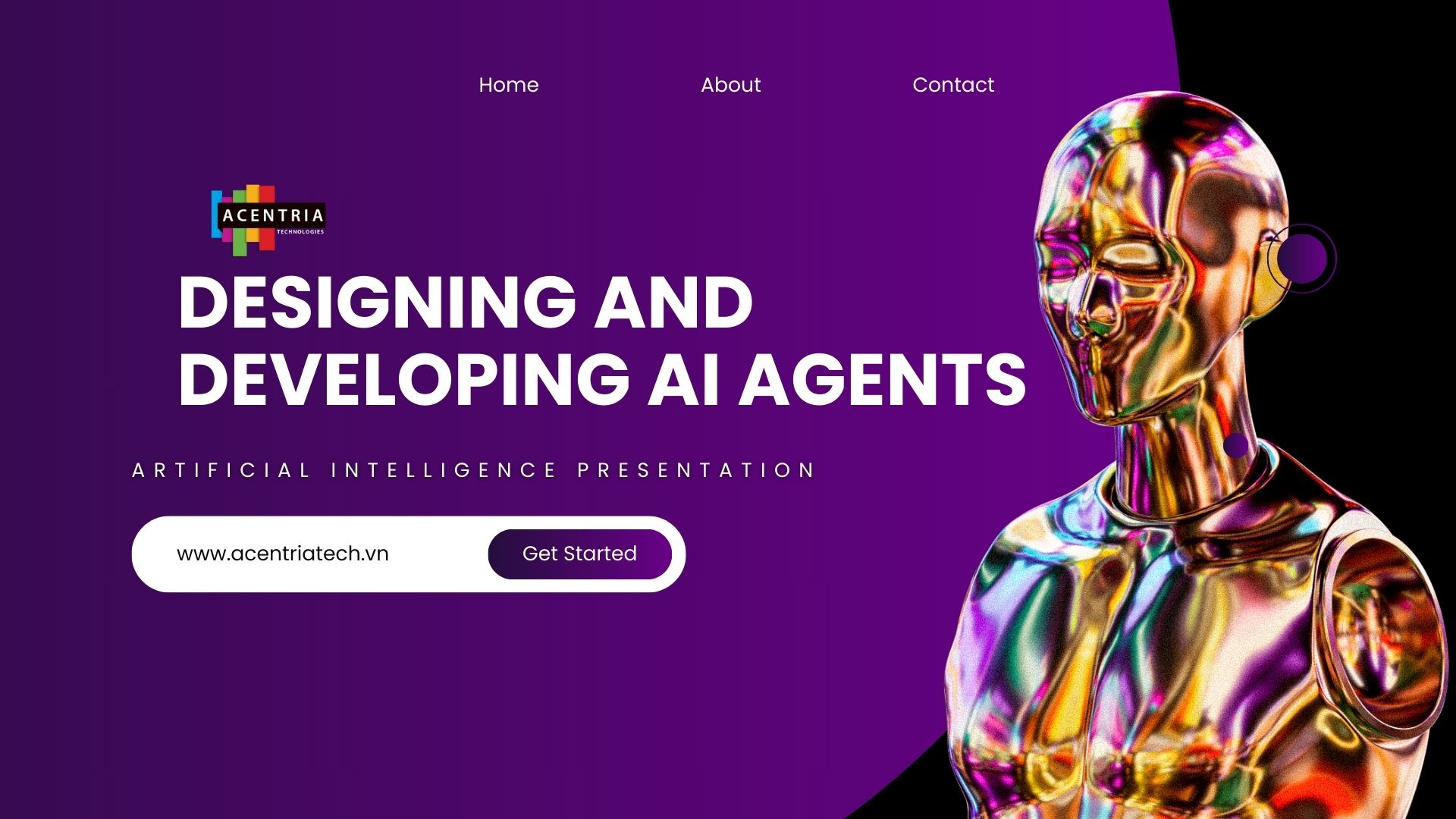Designing and Developing AI Agents: From Concept to Code
Artificial Intelligence (AI) is reshaping how machines interact with the world, making intelligent decisions and automating tasks that once required human thought. At the heart of this transformation are AI agents — software entities that perceive their environment, reason, and act autonomously to achieve specific goals. Whether you’re a Machine Learning Engineer or a curious developer, understanding how to build an AI agent is crucial in today’s rapidly evolving tech landscape.
This blog walks you through the full journey of designing and developing AI agents, from conceptualization to Designing and Developing AI Agents the actual code. We’ll also explore the tools, frameworks, and platforms such as Azure Machine Learning that can empower your AI development process.
What is an AI Agent?
An Designing and Developing AI Agents is a system capable of perceiving its environment through sensors, processing this information, and taking actions through actuators. The goal is to perform tasks intelligently, often learning and adapting over time. Examples include chatbots, self-driving cars, recommendation systems, and virtual assistants.
Types of AI Agents:
Simple Reflex Agents: Respond to current percepts.
Model-based Agents: Maintain internal states.
Goal-based Agents: Make decisions to achieve specific goals.
Utility-based Agents: Optimize for maximum benefit.
Learning Agents: Improve performance over time using past experiences.
Step 1: Defining the Problem
- Before jumping into coding, define what your AI agent should achieve. A well-scoped problem ensures that the development process is focused and measurable. Ask yourself:
- What is the objective of the agent?
- What are the expected inputs and outputs?
- What environment will it operate in?
- Does it require learning capabilities?
Example Use Case: Building a customer support chatbot that answers product-related queries.
Step 2: Designing the Agent Architecture
The architecture of your AI agent determines how it processes information and interacts with its environment. For many applications, a modular design is most effective, comprising the following:
- Perception Module: Captures and preprocesses data.
- Reasoning Module: Uses rules, logic, or ML models to make decisions.
- Learning Module (optional): Implements reinforcement learning or supervised learning.
- Action Module: Executes tasks based on decisions.
For chatbots, for example, the architecture may include:
- NLP pipeline for input processing
- Dialog management system
- Response generation engine
Step 3: Choosing the Right Tools and Frameworks
A wide range of tools is available to help build AI agents. Here are some popular ones:
Programming Languages:
- Python (most popular for AI/ML)
- JavaScript (for web-based AI agents)
Frameworks & Libraries:
- TensorFlow, PyTorch (for deep learning)
- Scikit-learn (for traditional ML)
- OpenAI Gym (for reinforcement learning)
- Rasa, Dialogflow (for chatbot agents)
Cloud Platforms:
- Azure Machine Learning: A powerful platform for building, training, and deploying machine learning models. Ideal for enterprise-grade applications for Digital Transformation.
- AWS SageMaker, Google AI Platform
Step 4: Data Collection and Preprocessing
Data is the fuel of any AI agent. Depending on the task, you may need text, images, audio, or sensor data. Key steps include:
- Data Gathering: From APIs, databases, sensors, or manual entry.
- Cleaning & Labeling: Removing noise, handling missing values.
- Feature Engineering: Extracting relevant information.
- Splitting: Dividing into training, validation, and test sets.
If you’re using Azure Machine Learning, it provides pipelines to automate data preprocessing and versioning, saving time and effort.
Step 5: Model Selection and Training
Now comes the core of your AI agent: the learning model. Depending on your application, choose from
- Classification models (e.g., for spam detection)
- Regression models (e.g., for predicting sales)
- Sequence models (e.g., LSTMs for text-based tasks)
- Reinforcement Learning (e.g., for gaming or robotics)
In Azure, you can use built-in algorithms or bring your own model. Azure also supports AutoML, which can automatically select the best model and hyperparameters.
Training Tips:
- Ensure your data is balanced and diverse.
- Use cross-validation to prevent overfitting.
Monitor metrics like accuracy, F1-score, or AUC depending on the task.
Step 6: Integrating the Agent with the Environment
Once the model is trained, embed it into the agent’s architecture. Integration depends on the application:
- For web apps: Use REST APIs to interact with backend models.
- For physical robots: Integrate with sensors and actuators.
- For enterprise apps: Use cloud services like Azure Functions to deploy and scale.
Azure Machine Learning allows easy deployment through containers and REST endpoints, making integration seamless.
Step 7: Testing and Evaluation
Before full deployment, thoroughly test your Designing and Developing AI Agents in simulated or real environments. Consider:
- Unit Testing: Individual modules work as expected.
- Integration Testing: Modules interact correctly.
- Performance Evaluation: Response time, accuracy, user satisfaction.
Example: A chatbot can be evaluated using:
- BLEU score for language quality
- Precision and recall for intent detection
- User feedback and engagement metrics
Step 8: Deployment and Monitoring
After successful testing, deploy your AI agent to the production environment. Tools like Azure Machine Learning offer:
- Scalable model deployment using Kubernetes or Azure Functions
- Monitoring dashboards to track performance and errors
- Automated retraining pipelines
Don’t forget to implement feedback loops for continuous learning and improvement.
Use Case Example: AI Agent for Predictive Maintenance
Let’s consider a predictive maintenance agent for factory equipment:
- Environment: IoT sensors on machinery
- Perception: Real-time temperature, vibration, and pressure data
- Reasoning: ML model predicts equipment failure
- Action: Notifies maintenance team before a breakdown
With Azure Machine Learning, sensor data can be ingested through Azure IoT Hub, processed, and used to train a model that predicts anomalies in equipment behavior.
Challenges in Building AI Agents
While building AI agents is exciting, it also comes with challenges:
- Data Quality: Garbage in, garbage out. Ensure clean and relevant data.
- Bias and Fairness: Models may reflect or amplify biases in the training data.
- Scalability: Not all models scale well with increased data and user load.
- Explainability: Make AI decisions transparent for debugging and trust.
Platforms like Azure offer explainability tools and bias detection to help mitigate these issues.
Final Thoughts
Learning how to Designing and Developing AI Agents is a journey that blends creativity, logic, and continuous learning. Whether you’re using open-source tools or enterprise-grade platforms like Azure Machine Learning, the possibilities are endless. As a machine learning engineer, developing AI agents enables you to solve complex real-world problems, from intelligent customer service to autonomous vehicles.
The process involves careful planning, the right technological choices, and a deep understanding of the environment and goals. As the field of AI continues to grow, mastering the art of building intelligent agents will remain a valuable and impactful skill.
So, are you ready to turn your AI agent idea into reality? Start small, build iteratively, and let data drive your innovation!




